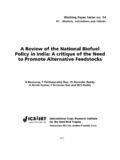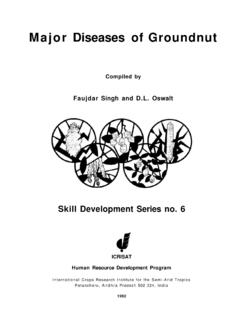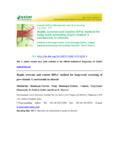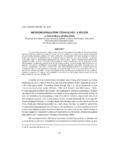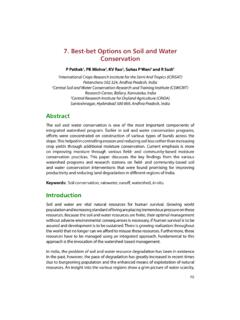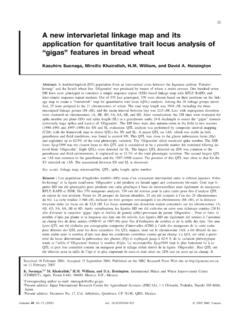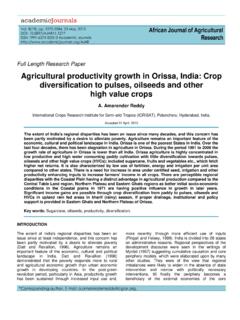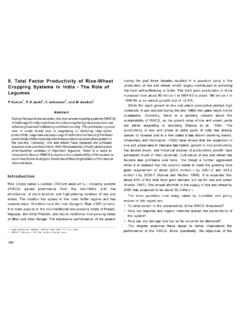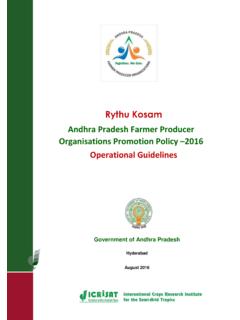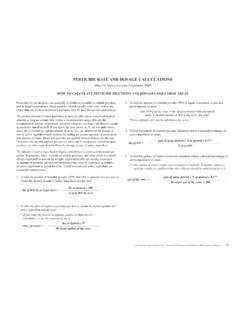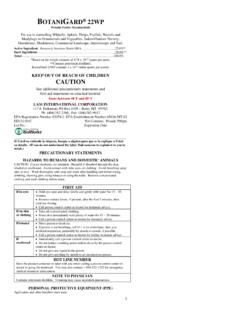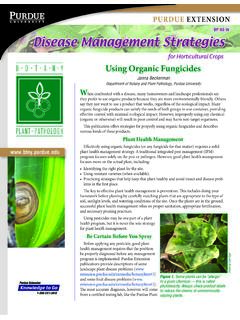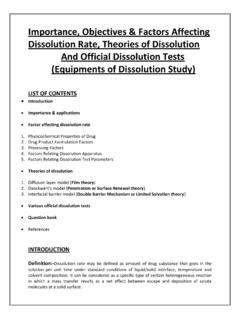Transcription of Pest Control - ICRISAT
1 Pest Control Compiled by Pal and Das Gupta Skill Development Series no. 15. ICRISAT . Training and Fellowships Program International Crops Research Institute for the Semi-Arid Tropics Patancheru 502 324, Andhra Pradesh, India 1994. Pest Control Compiled by Pal and Das Gupta Skill Development Series no. 15. ICRISAT . Training and Fellowships Program International Crops Research Institute lor the Semi-Arid Tropics Patancheru, Andhra Pradesh 502 324, India 1994. Training and Fellowships Program Publications in this Skill Development Series (SDS) are issued semiformally for limited distribution to program participants, colleagues, and collaborators. Copies may be requested by the S D S number. Constructive criticism from readers is welcomed by: Program Leader, Training and Fellowships Program, ICRISAT . Contributors for this issue are Mr. Pal, Manager, Plant Protection, Farm Engineering and Services Program, and Dr. Das Gupta, Senior Training Officer, Training and Fellowships Program.
2 Acknowledgments Information presented in this document has been taken from published and unpublished reports. Efforts have been made to indicate trade names ( ) where available. Omissions or inclusions of a trade name does not constitute endorsement or discrimination of a product by ICRISAT or the compilers. This publication should not be cited as a reference. Comments and suggestions from Drs Sharma, Shanower, and D. McDonald for compiling this document are gratefully acknowledged. Thanks to Mr Prasad Rao and Mr Lingam for processing this publication. Contents Pesticides 1. Terminology and Definitions 1. Classification of Pesticides 1. Pesticide Formulation 3. Type of Formulations 4. Emulsifiable concentrates (EC) 4. wettable powders (WP) 7. Dusts 7. Granular pesticides 7. Pesticides nomenclature 7. Calculation of Insecticide Dosage 9. C o m m o n expression of recommended dosages 9. C o m m o n terms used in insecticide calculations 9. R e c o m m e n d e d dosages 10.
3 Calculations 10. Summary 12. Use and Operation of a Knapsack Sprayer 14. Steps for calibrating a sprayer 14. Determining the amount of nozzle discharge 14. Calculation of application rate 14. Calculation of sprayer loads 14. Maintenance of sprayers 15. Pest Surveillance 17. Surveillance methods 17. Protection Levels 19. Important Pests on ICRISAT Mandate Crops 20. References 26. Evaluations 27. Appendix 1 Plant Protection and Surveillance Unit: Data Sheet 30. Appendix II Surveillance Samples, Area Covered Person - 1 Day -1 , Number of Samples ha -1 , and Insect Pest to be Sampled 32. Appendix III Economic Threshold Levels 33. Appendix IV List and Clasification of Approved Pesticides (Common names) 39. Pesticides Terminology and Definitions The following are frequently used terms related to pesticides and their application. Pests Organisms such as insects, rodents, nematodes, fungi, weeds, birds, bacteria, viruses, etc., which damage the crops and reduce yield.
4 Pests are injurious to human health and/or farmers economic efforts. Pesticides Chemicals or mixtures of chemicals that are used for killing. repelling, mitigating or reducing pest damage. Herbicides Substances used for inhibiting growth of plants, plant parts, or to kill/destroy the plants. Defoliants Substances that initiate leaves to fall. Desiccants Substances that cause plant tissue to dry up. Fungicides Substances that prevent, destroy or inhibit the growth of fungi in crop plants. Insecticides Substances that prevent, inhibit, destroy, kill insects (belonging to Class Insecta, Phylum arthropoda). Rodenticides Substances that prevent, inhibit, destroy, kill rodents (Class Mammalia, Order Rodentia). Miticides/Acaricldes Substances that prevent, inhibit, destroy, kill or mitigate mites (Acarina arachnid arthropods). Nematicides Chemicals that prevent, repel, inhibit or destroy members of the Class Nematoda. Molluscicides Prevent, repel, inhibit or destroy members of the Phylum Mollusca such as snails.
5 Formulation The form in which a pesticide is sold for use. Active ingredient ( ) is a part of a pesticide formulation which is the actual toxicant sometimes referred to as "technical grade" or "basic pesticide". Inert ingredients Substances, other than the active ingredient, which constitute a pesticide formulation. Classification of Pesticides Pesticides may be classified according to: a) the target pest species. b) their chemical constitution c) their site of action TAFP SDS no 15 1. Classification based on target pest species The following explains the classification of pesticides based on target organisms. For certain organisms, subclassifications are also made. Pesticide classification Target organisms Pesticide Fungi Fungicides Microorganisms Algae Algaecides Bacteria Bactericides Arachnids Acaricides or Miticide Insects Insecticides Molluscs Molluscicides Nematodes Nematicides Rodents Rodenticides Birds Avicides Plants Weedicides or Herbicides Classification based on chemical nature The classification of pesticides based on their chemical nature is rather complex.
6 Modern pesticides are, in general, organic chemicals (compounds with carbon). However, some inorganic compounds are also used as pesticides. The organic pesticides can be subdivided into classes based on their molecular structure. These classes are organochlorines, organophosphates, carbamates, organomercurials, thiocarbamates, acetamides, ureas, etc. Combining the two methods of classification based on target species and chemical nature, a useful classification system is obtained. This is given below. Pesticides Insecticides Inorganic Fungicides Herbicides Rodenticides Organochlorines Pyrethroids Insecticides Organophosphates Other organics Carbamates Nitropenols Uracils Herbicides Chlorophenoxy Triazines Organic compounds Thiocarbamates Dipyridyls Other organics Ureas Organotins Organophosphates Fungicides Organomercurials Other organics Dithiocarbamates 2 TAFP SDS no 15. Appendix IV lists pesticides approved in India under the Insecticides Act, 1968, and their class based on target organisms and chemical nature.
7 It should be remembered that a pesticide may appear in more than one class based on its target species, but will be in only one class based on its chemical nature. Classification based on site of action By segmenting insecticides/acaricides and fungicides separately, insecticides/ acaricides can be classified on the basis of their routes of entry into the body system of the target pest. They can be grouped as follows. i) Stomach poisons. ii) Contact poisons. iii) Systemic poisons. iv) Fumigants. Stomach poisons Stomach poisons enter the body of the pest through the mouth during feeding into the digestive tract from where these are absorbed into the systems. Stomach poisons are more effective against c h e w i n g i n s e c t s and useful in controlling insects with siphoning or sponging types of mouth parts (housefly for an example). Examples: dieldrin, sulfur, lead arsenate, etc. Contact poisons These poisons enter the body directly through the cuticle by contact with the treated surface of the foliage, stem, etc.
8 These poisons act on the nervous system of the pest. These may also be applied directly on to the body of the pest as a spray or dust. Examples: benzene hexachloride. dichloro diphenyl trichloro ethane, endrin, quinalphos, carbamates, etc. Some of the known pesticides derived from plants also have contact action. Examples: pyrethrum, rotenone, sabadilla. nicotine, etc. Systemic poisons These poisons are applied on the plants' surface such as the foliage, green parts of the stem, and near the roots from where these are translocated into the plant tissues. Most of the systemic poisons act as stomach poisons, or both as stomach and contact poisons. The parts of the plant where these poisons have been translocated become lethal to the pests feeding on these parts of the plants. Systemic poisons are more effective against sucking pests. They have a selective action with little effect on the predators and parasites directly, unless acting through the food chain. Translocation of these poisons takes place mostly through xylem vessels.
9 Examples: demeton-o-methyl, phosphamidon. monocrotophos. phorate. carbofuran. dimethoate, mevinphos, aldicarb, etc. Fumigants Fumigants are volatile poisons and enter the body of the pests through the respiratory system. These are widely used in controlling stored grain pests. All types of pests can be killed by fumigants irrespective of the types of mouthparts provided a gas-tight atmosphere is ensured ( , fumigants are nonselective). Even for soil pests such as nematodes, fumigation is effective. Examples: dichlorvos. hydrogen cyanide, methyl bromide, paradichlorobenzene, ethylene dichloride, carbon tetrachloride, naphthalene, nemagon, aluminum phosphide, etc. Pesticide Formulations Pesticides, with a few exceptions, are sold and used as formulated products. Formulating a pesticide improves its performance and increases its environmental safety. TAFP SDS no 15 3. Pesticides are first manufactured as technical grade (active ingredient or a . i ) . In this form, they are unsuitable for direct use because of the following reasons: - They have unsuitable physical characteristics.
10 They are generally waxy or lumpy solids or viscous liquids. In this f orm, they are difficult to apply. - They have high purity levels and hence the required dose is difficult to disperse. The quantity involved is very small to be evenly and effectively dispersed over a specified area. - The toxicity of the is much higher compared to the formulations. Thus, application of is not only hazardous but also needs specialized training and knowledge in handling. - The does not have the ideal physiochemical characteristics which the formulations have. Formulations contain the in a definite concentration together with other materials such as inert carriers, emulsifiers, wetting agents, solvents, thickeners, encapsulants, etc. According to the intended mode of application, the common formulations can be grouped as follows: A. For spraying after mixing with water/oil i) Emulsifiable concentrates (EC) (Fig. 1). ii) wettable powders (WP or WDP) (Fig. 2 and 3). iii) Ultra low volume concentrates (ULV).
